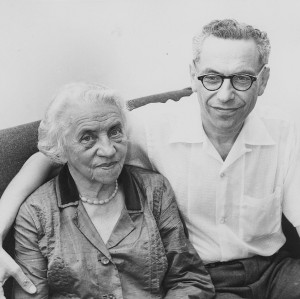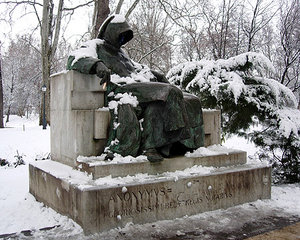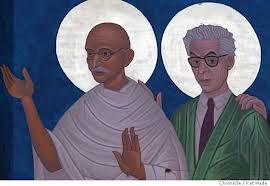Section 1.2 Paul Erdős
If numbers aren't beautiful, I don't know what is. — Paul Erdős, 1913 — 1996.
Who was Paul Erdős? Paul Erdős was a legendary mathematician who was so devoted to his subject that he lived as a mathematical pilgrim with no home and no job.
Paul Erdős made contributions to:
- combinatorics including Ramsey theory; a branch of mathematics concerning the study of finite or countable discrete structures
- graph theory; the study of graphs, which are mathematical structures used to model pairwise relations between objects
- number theory; a branch of pure mathematics devoted primarily to the study of the integers
- classical analysis; a branch of mathematics that includes the theories of differentiation, integration, measure, limits, infinite series, and analytic functions
- approximation theory; study of how given quantities can be approximated by other (usually simpler) ones under appropriate conditions.
- set theory; branch of mathematics that deals with the properties of well-defined collections of objects, which may or may not be of a mathematical nature
- probability theory; a branch of mathematics concerned with the analysis of random phenomena
Birth and Death. Paul Erdős was born in Budapest, Hungary, on March 26, 1913, and died at the age of 83 on September 20, 1996, in Warsaw, Poland.

World in 1913
World in 1996
The first wireless transmission between the USA and Germany
The first version of the Java programming language was released
The concept of the “isotope” introduced
IBM's Deep Blue wins a game of chess against Gary Kasparov
Port Coquitlam, BC, established
The first surface photos of Pluto
All-purpose zipper patented
The 34th known Mersenne prime \(2^{1257787}-1\) discovered
The first four engine aircraft built
Nintendo 64 goes on sale
The Pacific Highway between Surrey, BC, and Blaine, WA, opened as a gravel road
Microsoft releases Internet Explorer 3.0
The brand name “Oreo” was registered
Netscape Browser 3.0 is released
Mohandas Gandhi arrested for leading Indian miners march in South Africa
South Africa adopts post-apartheid constitution
Rabindranath Tagore presented with the Nobel Prize
The last federally run Indian residential school closed in Saskatchewan
Paul's Family. Paul Erdős came from a Jewish family. The original family name being Engländer. Paul's father Lajos and his mother Anna had two daughters, aged three and five, who died of scarlet fever just days before Paul was born. This had the effect of making Paul's parents protective of their son. Both of Paul's parents were teachers of mathematics.
Stanisław Ulam About Paul Erdős in 1976:
He had been a true child prodigy, publishing his first results at the age of eighteen in number theory and in combinatorial analysis. Being Jewish he had to leave Hungary, and as it turned out, this saved his life. In 1941 he was twenty-seven years old, homesick, unhappy, and constantly worried about the fate of his mother who remained in Hungary. (…) Erdős is somewhat below medium height, an extremely nervous and agitated person. (…) His eyes indicated he was always thinking about mathematics, a process interrupted only by his rather pessimistic statements on world affairs, politics, or human affairs in general, which he viewed darkly. (…) His peculiarities are so numerous it is impossible to describe them all. (…) Now over sixty, he has more than seven hundred papers to his credit. (Source: MacTutor.)
Erdős' Work - Two Examples.
Example 1.2.2.
Happy ending problem:
During the winter of 1932–1933 a group of students was meeting regularly in the park Városliget, Budapest, Hungary. Among them were Pál “Paul” Erdős, Eszter “Esther” Klein, György “George” Szekeres, and Endre “Andre” Makai.

One day, Esther made the following observation:
Among any five points in general position in the Euclidean plane, it is always possible to select four points that form the vertices of a convex quadrilateral.
Vocabulary:
-
“five points in general position in the Euclidean plane” = no three points are on the same line (See Figure 1.2.4.)
Figure 1.2.4. \(\color{blue}{\text{Points in general position}}\) and \(\color{red}{\text{points not in general position}}\) -
“a convex quadrilateral” = a quadrilateral with the property that if two points \(A\) and \(B\) are inside of the quadrilateral then the whole segment \(\overline{AB}\) is inside the quadrilateral. See Figure 1.2.5.
Figure 1.2.5. \(\color{blue}{\text{Convex quadrilateral}}\) and \(\color{red}{\text{non-convex quadrilateral}}\)
Proof of Esther's observation: The convex hull of a set of points \(S\) in the Euclidean plane is the smallest convex set that contains all points from \(S\text{.}\) See Figure 1.2.6.
Makai soon proved that among any nine points in general position, it is always possible to select five points that form the vertices of a convex pentagon. See Figure 1.2.7
Klein suggested the following more general problem:
Given any positive integer \(n\text{,}\) there exists a number \(K(n\)) such that among any \(K(n)\) points in general position, it is possible to select \(n\) points that form the vertices of a convex \(n\)-gon.
This is what Szekers wrote about what happened next:
I have no clear recollection how the generalization actually came about; in the paper we attributed it to Esther, but she assures me that Paul had much more to do with it. We soon realized that a simple-minded argument would not do and there was a feeling of excitement that a new type of geometric problem emerged from our circle which we were only too eager to solve. For me that it came from Epszi (Paul's name for Esther, short for “epsilon” ) added a strong incentive to be the first with a solution and after a few weeks I was able to confront Paul with a triumphant ‘E.P. open your wise mind’. What I had really found was Ramsey's Theorem from which [the theorem] easily followed. Of course, at that time none of us knew about Ramsey. (Source “Roots of Ramsey theory” by R. Graham.)
Esther and George married in 1937. On August 28, 2005, they died within an hour of each other.
Example 1.2.8.
Conjecture: If \(A\) is a set of positive integers such that
then A contains arithmetic progressions of any given length.
Paul Erdős offered a prize of US $3000 for a proof of this conjecture. For more details, see Wikipedia.
Resources.
